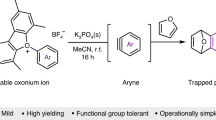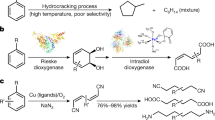Abstract
Arynes (aromatic systems containing, formally, a carbon–carbon triple bond) are among the most versatile of all reactive intermediates in organic chemistry. They can be ‘trapped’ to give products that are used as pharmaceuticals, agrochemicals, dyes, polymers and other fine chemicals. Here we explore a strategy that unites the de novo generation of benzynes—through a hexadehydro-Diels–Alder reaction—with their in situ elaboration into structurally complex benzenoid products. In the hexadehydro-Diels–Alder reaction, a 1,3-diyne is engaged in a [4+2] cycloisomerization with a ‘diynophile’ to produce the highly reactive benzyne intermediate. The reaction conditions for this simple, thermal transformation are notable for being free of metals and reagents. The subsequent and highly efficient trapping reactions increase the power of the overall process. Finally, we provide examples of how this de novo benzyne generation approach allows new modes of intrinsic reactivity to be revealed.
This is a preview of subscription content, access via your institution
Access options
Subscribe to this journal
Receive 51 print issues and online access
$199.00 per year
only $3.90 per issue
Buy this article
- Purchase on Springer Link
- Instant access to full article PDF
Prices may be subject to local taxes which are calculated during checkout




Similar content being viewed by others
References
Wenk, H. H., Winkler, M. & Sander, W. One century of aryne chemistry. Angew. Chem. Int. Edn 42, 502–528 (2003)
Hoffmann, R. W. Dehydrobenzene and Cycloalkynes (Organic Chemistry, A Series of Monographs, Vol. 11, Academic, 1967)
Pellissier, H. & Santelli, M. The use of arynes in organic synthesis. Tetrahedron 59, 701–730 (2003)
Dyke, A. M., Hester, A. J. & Lloyd-Jones, G. C. Organometallic generation and capture of ortho-arynes. Synthesis 4093–4112 (2006)
Sanz, R. Recent applications of aryne chemistry to organic synthesis. A review. Org. Prep. Proced. Int. 40, 215–291 (2008)
Gilchrist, T. L. in Science of Synthesis Vol. 43 (ed. Hopf, H.) 151–215 (Georg Thieme, 2008)
Chen, Y. & Larock, R. C. in Modern Arylation Methods (ed. Ackermann, L.) 401–473 (Wiley-VCH, 2009)
Kitamura, T. Synthetic methods for the generation and preparative application of benzyne. Aust. J. Chem. 63, 987–1001 (2010)
Tadross, P. M. & Stoltz, B. M. A comprehensive history of arynes in natural product total synthesis. Chem. Rev. 112, 3550–3577 (2012)
Gampe, C. M. & Carreira, E. M. Arynes and cyclohexyne in natural product synthesis. Angew. Chem. Int. Edn 51, 3766–3778 (2012)
Diels, O. & Alder, K. Syntheses in the hydroaromatic series [in German]. Justus Liebigs Ann. Chem. 460, 98–122 (1928)
Onishchenko, A. S. Diene Synthesis (Israel Program for Scientific Translations, 1964)
Nicolaou, K. C., Snyder, S. A., Montagnon, T. & Vassilikogiannakis, G. The Diels–Alder reaction in total synthesis. Angew. Chem. Int. Edn 41, 1668–1698 (2002)
Michael, A. & Bucher, J. E. Über die Einwirkung von Eissigsäureanhydrid auf Phenylpropiolsäure. Chem. Zentrblt. 731–733. (1898)
Wessig, P. & Müller, G. The dehydro-Diels–Alder reaction. Chem. Rev. 108, 2051–2063 (2008)
Bradley, A. Z. & Johnson, R. P. Thermolysis of 1,3,8-nonatriyne: evidence for intramolecular [2+4] cycloaromatization to a benzyne intermediate. J. Am. Chem. Soc. 119, 9917–9918 (1997)
Miyawaki, K., Suzuki, R., Kawano, T. & Ueda, I. Cycloaromatization of a non-conjugated polyenyne system: synthesis of 5H-benzo[d]fluoreno[3,2-b]pyrans via diradicals generated from 1-[2-{4-(2-alkoxymethylphenyl)butan-1,3-diynyl}]phenylpentan-2,4-diyn-l-ols and trapping evidence for the 1,2-didehydrobenzene diradical. Tetrahedr. Lett. 38, 3943–3946 (1997)
Kimura, H., Torikai, K., Miyawaki, K. & Ueda, I. Scope of the thermal cyclization of nonconjugated ene-yne-nitrile system: a facile synthesis of cyanofluorenol derivatives. Chem. Lett. 37, 662–663 (2008)
Tsui, J. A. & Sterenberg, B. T. A metal-templated 4 + 2 cycloaddition reaction of an alkyne and a diyne to form a 1,2-aryne. Organometallics 28, 4906–4908 (2009)
Uchiyama, M. et al. Generation of functionalized asymmetric benzynes with TMP-zincates. Effects of ligands on selectivity and reactivity of zincates. J. Am. Chem. Soc. 124, 8514–8515 (2002)
Chang, W.-T. et al. Cross-coupling with organosilicon compounds. Org. React. 75, 213–746 (2011)
Stiles, M., Miller, R. G. & Burckhardt, U. Reactions of benzyne intermediates in non-basic media. J. Am. Chem. Soc. 85, 1792–1797 (1963)
Liu, Z. & Larock, R. C. Facile O-arylation of phenols and carboxylic acids. Org. Lett. 6, 99–102 (2004)
Cheong, P. H.-Y. et al. Indolyne and aryne distortions and nucleophilic regioselectivities. J. Am. Chem. Soc. 132, 1267–1269 (2010)
Garr, A. N. et al. Experimental and theoretical investigations into the unusual regioselectivity of 4,5-, 5,6-, and 6,7-indole aryne cycloadditions. Org. Lett. 12, 96–99 (2010)
Zhao, Y. & Truhlar, D. G. The M06 suite of density functionals for main group thermochemistry, thermochemical kinetics, noncovalent interactions, excited states, and transition elements: two new functionals and systematic testing of four M06-class functionals and 12 other functionals. Theor. Chem. Acc. 120, 215–241 (2008)
Ajaz, A. et al. Concerted vs. stepwise mechanisms in dehydro-Diels−Alder reactions. J. Org. Chem. 76, 9320–9328 (2011)
Johnson, R. P. & Daoust, K. J. Interconversions of cyclobutyne, cyclopentyne, cyclohexyne, and their corresponding cycloalkylidene carbenes. J. Am. Chem. Soc. 117, 362–367 (1995)
Acknowledgements
P.H.W. thanks the National Science Foundation for a graduate research fellowship. Financial support from the National Institutes of Health (GM65597 and CA76497) is acknowledged. This work was carried out in part using hardware and software provided by the University of Minnesota Supercomputing Institute.
Author information
Authors and Affiliations
Contributions
B.B. performed the initial experiments. All authors designed the experiments, analysed the data and wrote the manuscript.
Corresponding author
Ethics declarations
Competing interests
The authors declare no competing financial interests.
Supplementary information
Supplementary Information
This file contains Supplementary Text and Data comprising: I) General Experimental Protocols; II) Supplementary Figure 1; III) Preparation procedures and characterization data for all key compounds; IV) Computational details for geometry of fluorenonyne 24; V) Computational details for aryne 27-comp generation and trapping; VI) Copies of 1H and 13C NMR spectra of each isolated compound; VI) Supplementary References – see Contents for more details. (PDF 3552 kb)
Rights and permissions
About this article
Cite this article
Hoye, T., Baire, B., Niu, D. et al. The hexadehydro-Diels–Alder reaction. Nature 490, 208–212 (2012). https://doi.org/10.1038/nature11518
Received:
Accepted:
Published:
Issue Date:
DOI: https://doi.org/10.1038/nature11518
This article is cited by
-
N-heterocyclic carbene-catalyzed arene formation reactions
Science China Chemistry (2022)
-
Gold(I)-catalyzed intramolecular cyclization/intermolecular cycloaddition cascade as a fast track to polycarbocycles and mechanistic insights
Nature Communications (2021)
-
Oxidative [4+2] annulation of styrenes with alkynes under external-oxidant-free conditions
Nature Communications (2018)
-
The domino hexadehydro-Diels–Alder reaction transforms polyynes to benzynes to naphthynes to anthracynes to tetracynes (and beyond?)
Nature Chemistry (2018)
-
Polyyne formation via skeletal rearrangement induced by atomic manipulation
Nature Chemistry (2018)
Comments
By submitting a comment you agree to abide by our Terms and Community Guidelines. If you find something abusive or that does not comply with our terms or guidelines please flag it as inappropriate.



